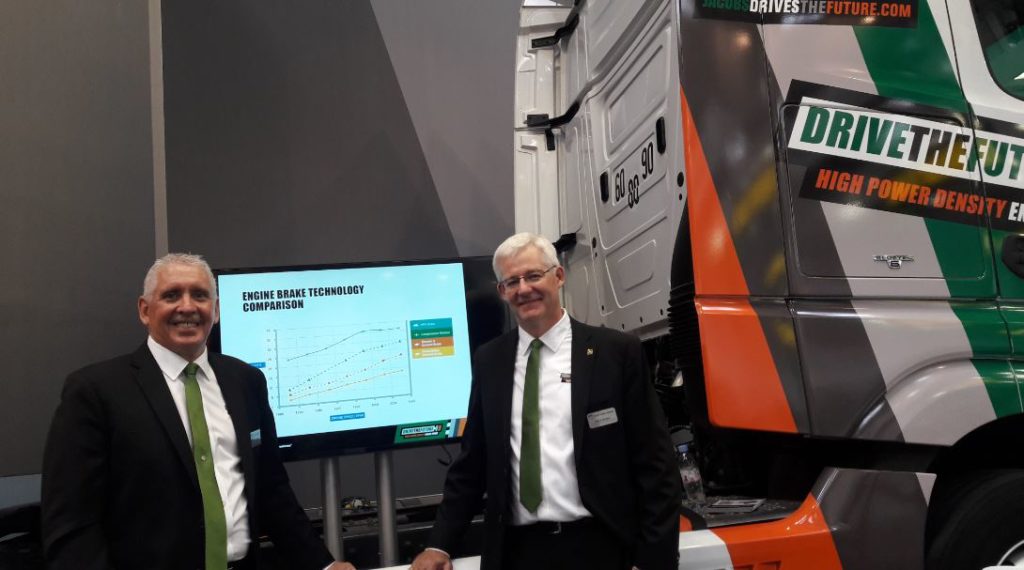Jacobs Vehicle Systems, the world’s leading manufacturer of heavy-duty diesel engine retarding systems and valve actuation mechanisms, further emphasizes its High Power Density (HPD) Engine Brake technology at the 66th IAA Commercial Vehicles. A demo truck equipped with the HPD Engine Brake has been touring test tracks and vehicle and engine OEM facilities across Europe since April and has taken centre stage on the Jacobs’ stand B34 in Hall 16.
The production-ready Jacobs’ HPD Engine Brake realises one-and-a-half times the braking performance of traditional compression release braking over the engine’s entire operating range and more than two times the braking performance at lower rpm (the same retardation at 1400 rpm as at 2100 rpm previously). Jacobs’ new calibration and revised cam design delivers 2000 Nm of retarding torque at 1300 rpm and beyond and 611 kW power at 2500 rpm in a 13-litre engine, compared to 416 kW at 2100 rpm on the standard, identical engine. This provides large engine displacement retarding power in small and medium displacement diesel and natural gas engines. While delivering revolutionary braking performance, the HPD system is quiet in operation (it had notably lower peak positive power noise than the four-stroke engine braking in NVH drive-by tests), being fully integrated into the customer engine’s overhead design. It can also assist with exhaust after treatment thermal management by preventing the catalyst from cooling during descents.
Mr. Sergio Sgarbi, Jacobs Vehicle Systems President, said: “Jacobs invented the High Power Density Engine Brake five years ago, bringing the technology to the point where this year, we became ready to invite customers to drive it for the first time in a modified demo truck. At IAA, we would like to invite more potential customers who have heard about HPD in the media and from industry colleagues to come to our booth and learn more about the technology. We see a perfect opportunity for the HPD brake in Europe, where there is a premium on retarding power and where Jacobs’ conventional compression release engine braking has been adopted by Daimler, Renault, DAF, Deutz and Volvo. ”
Jacobs’ HPD Engine Brake was developed in response to the drive by global engine suppliers to provide higher levels of engine braking performance at lower engine speeds and improve thermal management to match industry trends such as down speeding and downsizing of engines, which are driven by the need for better fuel economy and lower total cost of ownership. Engine brake retarding performance is becoming increasingly important because key strategies for improving fuel efficiency are reducing the natural retarding of the vehicle caused by wind resistance, engine, drive train, and rolling resistance from the tyres.
The brake transforms the four stroke engine into a two stroke compression device by deactivating the main intake and exhaust valve events and supplementing with two stroke valve events. Whereas a conventional engine brake has one compression release and one brake gas recirculation event per cam rotation, this innovative and patented two-stroke technology achieves two braking events per cam rotation. It is fully variable with controlled boost modulation, which allows the driver to achieve the right balance between retardation, speed and efficiency.
Another effect of market demand for improved fuel economy is the conversion of some fleet vehicles to natural gas engines, whose smaller turbochargers and lower compression ratios can diminish brake retarding power by up to 25 per cent. HPD compensates for this loss so that fleets can still haul standard load sizes safely.
During a week-long test drive event at Millbrook Proving Grounds in Bedfordshire, UK, in April 2016, Mr. Sgarbi said: “There is significant market potential for Jacobs’ HPD Engine Brake in Europe, where Jacobs’ compression release engine braking has already been adopted by Daimler, Renault, DAF, Deutz and Volvo. But whereas approximately 90 per cent of all heavy-duty trucks in the UK employ engine braking (a similar proportion to North America), take-up in Germany and other European markets is less than that.”
“The majority of European trucks still use hydraulic driveline retarders, which are dependent on vehicle speed for effectiveness, and are typically 175 kg heavier, with a corresponding penalty for the vehicle’s payload capacity. The Jacobs HPD Engine Brake can cope with those lower speeds, eliminating the need for a driveline retarder and becoming the primary choice in secondary braking,” continued Sgarbi.
Since Jacobs’ HPD Engine Brake uses standard, proven technology components, it also offers a cost advantage. At a fraction of the price of hydraulic retarder devices it delivers in average a return on investment in six months compared to an average of two-and-a-half years for hydraulic retarder devices.
Innovative two-stroke technology
At the heart of Jacobs’ HPD Engine Brake is innovative and patented two-stroke technology. Whereas a conventional engine brake has one compression release (CR) and one brake gas recirculation (BGR) event per cam rotation, HPD achieves two braking events per cam rotation. With standard four-stroke compression release engine braking, the compression release valve event occurs at the first Top Dead Centre timing at the end of the compression stroke in the four-stroke engine cycle. It is not possible to have a second compression release event at the second TDC timing as the exhaust valve has been open during the exhaust stroke preventing the build-up of pressure in the cylinder that results in retarding power. This results in there being only one compression release valve event during an engine cycle.
With HPD two-stroke braking, the compression release event is the same for the first TDC timing, but the main intake and exhaust valve events are deactivated using collapsing bridges enabling the build-up of pressure in the cylinder at the second TDC event which is released by a second compression release valve event. As there are now two compression release events for each engine cycle, the retarding power is significantly increased.
HPD valve motions also include supplementary intake valve motions and brake gas recirculation motions on the exhaust to enable the cylinder to fill enabling the maximum retarding power possible. The increase in power is achieved without exceeding any of the engine limits which constrain the four-stroke engine compression release engine power, such as cylinder pressure, as there are twice as many engine retarding events per cylinder with the two-stroke HPD retarding technology.
HPD technology consists of valve bridges incorporating a deactivating mechanism to disable the intake and exhaust main valve events from the main event rockers together with rocker arms to provide the intake and exhaust brake valve motions. The technology is based on well-established Jacobs’ hardware.
Cylinder deactivation improves economy and emissions
Cylinder deactivation mechanisms specially designed for HPD natural gas applications are used in the valve train to disable the opening of the intake and exhaust valves making the deactivated cylinders act as a gas spring, returning the compressed energy of the air back into the crankshaft. This reduces camshaft friction, reduces or eliminates use of the intake throttle, and improves fuel economy by reducing pumping losses in engine part-load conditions.
Cylinder deactivation can also be applied to diesel engines to improve emissions through faster Selective Catalytic Reduction (SCR) light off due to higher exhaust temperature. This flexibility allows cylinders to warm up the after-treatment system more quickly during cold start and maintain the SCR temperature during low load operation, thereby reducing harmful NOx emissions.
Easy to integrate and easy to operate
To integrate the HPD Engine Brake’s retarding function into the engine design, Jacobs’ engineers work closely with leading diesel engine manufacturers from an early stage in design, development and testing. This alliance of capabilities, combining the engine manufacturers’ expertise in combustion with Jacobs’ expertise in retarding and valve actuation, is now a well-refined process, proven with manufacturers in North America, Europe, China, Japan, and Korea.
Operating the Jacobs’ HPD Engine Brake is simplicity itself. Although fully integrated with the engine, the brake only becomes available to the driver when the cab-mounted engine brake switch is set to ‘On’. A lever on the steering wheel controls its braking power, which can be designed to any level desired. The brake will engage automatically when the accelerator pedal is fully released and disengage when the accelerator pedal is pressed. This provides smooth braking and reassuring speed control on downward gradients, eliminating the need for extensive downshifting.


